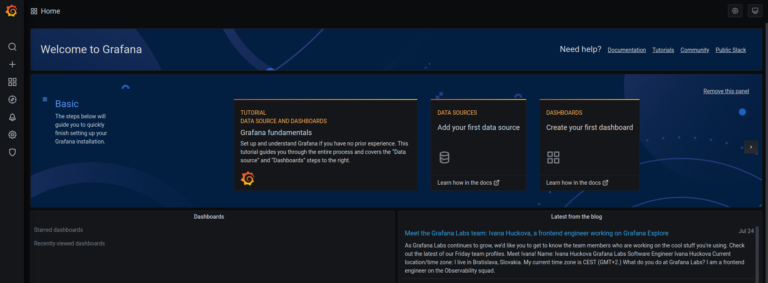

To begin, let’s set up the tools we’ll need to build our dashboard template: the Grafonnet library and a Jsonnet compiler. In our running example below, we’ll use the currently available library, which is good enough for most use cases. Right now Grafonnet is still under development, and a new version of the Jsonnet templates for Grafana > 7.0 is on its way. Grafana provides a set of Jsonnet templates (called Grafonnet) to quickly and easily write dashboards programmatically. It supports YAML, JSON and INI output formats, and provides useful tools such as a syntax checker and a formatter. Jsonnet is a JSON templating language for generating config files. This language should be both expressive and powerful: for this we decided to use Jsonnet. Moreover, since we want to create maintainable dashboards that can be deployed for multiple organizations, we’ll need a templating language to generate the dashboard’s JSON representation. The versioning system should allow us to keep track of changes in the dashboards, thanks to git, and be able to immediately roll back the dashboards for all the clients if some dashboard bug is pushed into production.
#Ntopng grafana update#
By using Jenkins, an open source automation server, we can deploy the same dashboard for all users even though they are spread across different companies (different orgs in Grafana) and automatically update the dashboards for all clients once a new version of the dashboard is pushed to a git repository. We’ll want to divide our dashboards into rows, with one row for each metric. InfluxDB, Telegraf and Grafana are the right tools to achieve this, and with the power of Flux, we can analyze the data efficiently and plot it using Grafana.
#Ntopng grafana windows#
Say we want to monitor the disk latency of SQL Servers or other Windows Performance Counters in a private cloud context, and plot the results for users of our performance management platform who likely work in different companies. 2021 Lorenzo Candeago ITOA Continuous Deployment of Grafana Dashboards Using Jsonnet and Jenkins, Part 1 We assume that you have installed web server correctly, then the next step is to run redis server.06. Save those files and we can continue to the next step Run ntopng You can use your favorite text editor to create ntopng configuration files. In this article we use vi as text editor. Next we need to create configuration files for ntopng. By default, redis and ntopng will installed in /usr/local/ folder if we don’t change the installation folder explicitly in. If everything is installed, then it’s time for us to running it. Since ntopng is a web-based application, your system must have a working web-server installed Create configuration files for ntopng Internet connection is required for this installation method. third-party/LuaJIT-2.0.2/src/libluajit.a : could not read symbols : File in wrong format On my CentOS 6.4, I got an error message when using Method 1.
#Ntopng grafana install#
Install libpcap # yum install libpcap libcap-devel To install the development tools you can use yum command : # yum groupinstall ‘Development Tools’ You have to make sure that you have all development tools which is needed to compile ntopng. But it may works also in other version of CentOS / RedHat based Linux. This article is tested on CentOS 6.4 32-bit version. For 32-bit operating system, you have to compile it from the source.
#Ntopng grafana download#
You may find the packages in their download page. Ntop is available in pre-compiled packages for CentOS dan Ubuntu 64-bit based.



 0 kommentar(er)
0 kommentar(er)
